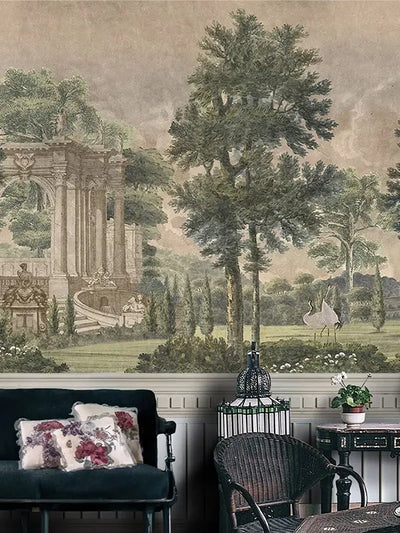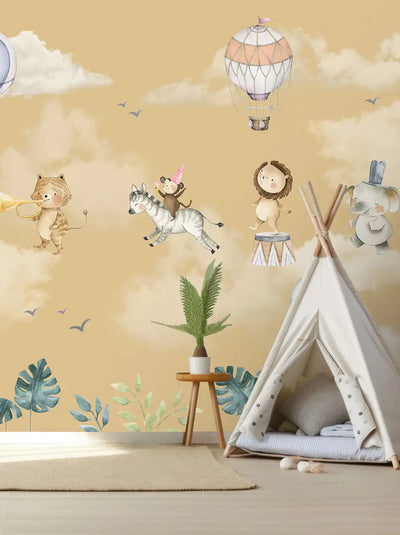If you've ever admired the Indian traditional art's colors and intricate patterns, you've probably seen Pichwai. This alluring aesthetic, which has its roots in spiritual and cultural legacy, is a centuries-old celebration, devotion, and artistry rather than merely a pretty picture. In this blog, we’ll examine the rich history of Pichwai art, and discover how it’s been brought into contemporary households.
Definition and History of Pichwai Art:
Pichwai comes from the Sanskrit word (pich) which means back, and (wais) hanging. It is a traditional Indian painting style that began in Nathdwara, Rajasthan.
In temples, these paintings are usually placed behind the idol of Lord Krishna. The art form is rooted in the Vaishvanism tradition, which considers Lord Krishna, the ultimate God and dates back to the 16th CE. Pichwai paintings began 400 years ago. These paintings are made with natural colors from minerals and plants and the artists were inspired by stories and myths about Lord Krishna which led them to create detailed paintings of his life.
The sacred backdrop for the Shrinathji idol, a manifestation of Krishna adored, in Nathdwara, are paintings by Pichwai. Over the ages, the art form has changed, maintaining its spiritual essence, while incorporating new techniques and styles.
Themes of Pichwai Art:
Pichwai paintings mainly focus on the different stages of Lord Krishna’s life, depicting his childhood, youth, and adulthood. Its themes keep varying with the seasons. The intricate designs of Pichwai are one of their unique features. Similar to the temple statue's attributes, these paintings of Shrinathji are very different with bulkier eyes and broad noses.
Harmonious and well-balanced patterns, flowers, and animals are just a few features that frequently abound in the paintings. Quite a few pictures depict pink lotuses in summer contrasting with the one for Sharad Purnima, which features a bright full moon in the night scene. The Pichwai cow painting against a background of flowers, also known as ‘The Kamdhenu’, is one of the most well-known motifs in this art form.
There are 24 boxes in a typical Pichwai art called swaroops, with Krishna, Gopis, and other components inside of them. In Pichwai paintings the choice of colors plays a role, in this loved art style. These artworks often feature colors like red, yellow, and green representing the dynamism and liveliness associated with Lord Krishna. Traditionally, the artists created these paintings on fabric or paper using dyes from plants and minerals such, as saffron, gold, silver, zinc, coal, and indigo.
Pichwai paintings are renowned for their complex details, ornate borders, and fine brushwork and have gained popularity all around the world, as they are made on surfaces that include silk, paper, and canvases.
Importance of Pichwai in the Modern Times:
Pichwai paintings are seen in Hindu temples and have gained popularity as a form of decorative art. These artistic paintings of cows are commonly used to adorn homes and indoor spaces, representing Hindu culture, spirituality, and aesthetics. Pichwai art remains a choice, in the realm of Indian paintings with many artists in Rajasthan dedicatedly creating these artworks using time-honored methods and materials.
The Nathdwara painting school in Rajasthan is a special space where the art of Pichwai painting is taught through generations in the traditional guru-shishya system. Today, these intricate Pichwai wallpaper for wall are not just limited to paintings but they adorn clothing like sarees and dupatta bringing a touch of tradition to fashion. Bandhani Pichwai sarees and printed Pichwai sarees have become popular choices, blending timeless art with contemporary style.
Life n Colors adorns your walls with Pichwai Designs:
At Life n Colors, we’re passionate about bringing the beauty of Indian Pichwai art to your home through our unique wallpapers and fabrics. By incorporating rich, story-based designs, we aim to get a luxurious feel to any space of your home, transforming it into a canvas of cultural elegance and artistic heritage.
We are committed to bringing the classic beauty of Pichwai art into your homes and adorning your walls with vivid age-old artistry. Life n Colors, transforms ordinary spaces, into beautiful wallpapers of elegance and tradition by initiating the rich and detailed patterns of Pichwai art to your walls. These designs use a unique way to enrich with cultural artistry, creating spaces that are both visually stunning and inviting. Our design team has curated best-selling Pichwai wallpapers for your spaces which can make your walls look brighter and spectacular.
Transform your home with a vibrant touch of Indian aesthetic through our stunning wallpaper with a bright blue backdrop with beautifully detailed cows.
See Pichwai Wallpaper Collection

Our top selling pichwai wallpaper designs include
1- Pichwai Style Wallpaper for Lobby and Temple Walls, Yellow
2- Divine Glow: Beautiful Yellow Pichwai Wallpaper for Pooja Room
3- Pichwai Shrinathji Room Wallpaper With Cows
4- Sacred Grove Pichwai Room Wallpaper
5- Surabhi Pichwai Wallpaper, Customised for Walls
6- Pichwai Cow Painting Inspired Wallpaper for Walls
7- Chitran Pichwai Style Wallpaper Designed for Walls Yellow Color
Conclusion:
The art faced some challenges, naturally occurring dyes were hard to find which became a problem for Pichwai art. The plants and minerals that were used to make traditional dyes were getting harder to find. Pichwai artists face challenges from other artistic mediums as modern art forms compete with traditional styles.
Despite the challenges, Pichwai art remains an important part of Indian culture, and by preserving its traditional methods and materials, we can ensure the long-term survival of this beautiful and spiritually significant art form. So if you have the vision, we have the mission to keep this art alive. Visit our website of lifencolors to know more about our Pichwai collection and fill your home spaces, corners, and walls with our best collections of Pichwai art.


















